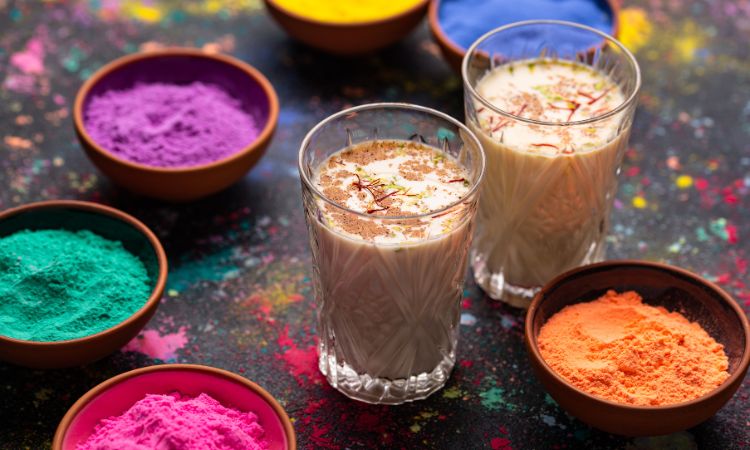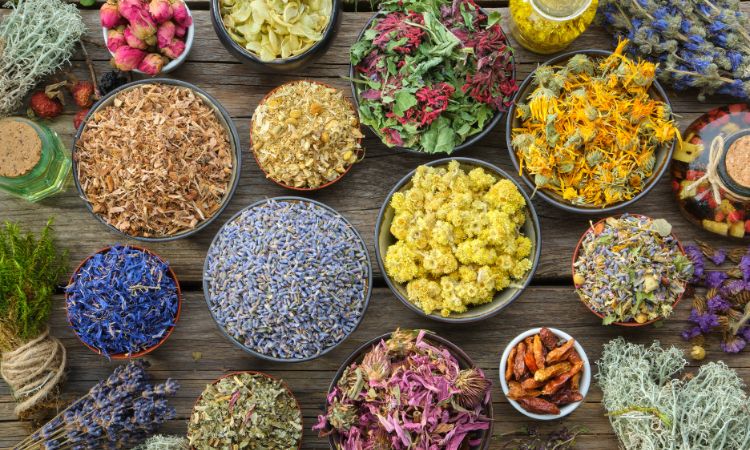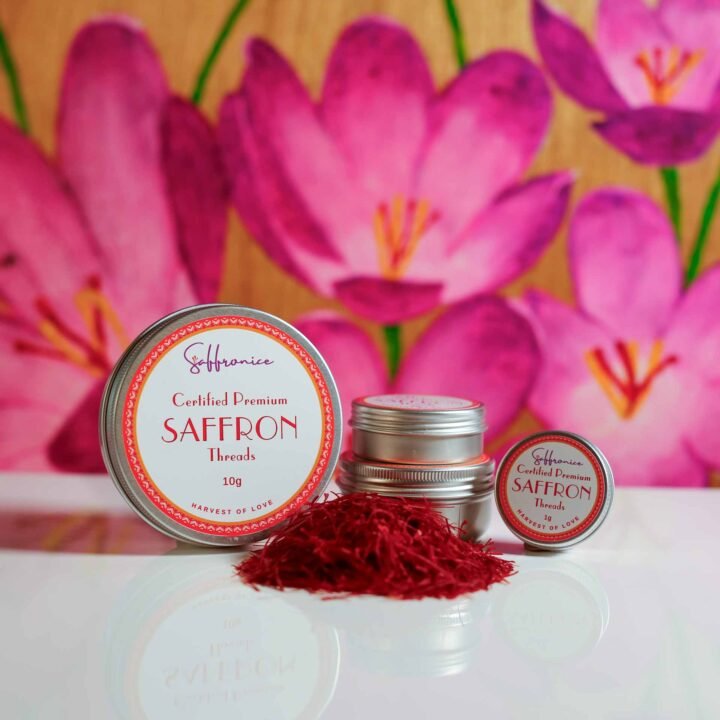Did you know saffron, the world’s most expensive spice, can cost up to $5,000 per pound? Yet its extraordinary price reflects far more than culinary exclusivity. For nearly 4,000 years, saffron has been a cornerstone of Ayurvedic medicine, valued for supporting mental health, combating inflammation, and promoting cellular wellness. Welcome to the world of Ayurvedic “red gold”—where ancient healing wisdom meets contemporary scientific validation.
As we explore saffron’s remarkable benefits through the lens of Ayurvedic tradition, prepare to discover how this precious spice supports mood enhancement, cognitive function, anti-aging, and skin health. Whether you seek to improve overall wellness, address specific health concerns, or simply understand this ancient medicine’s profound applications, saffron offers transformative potential for your health journey.
🔑 Key Takeaways:
- Saffron ranks as the world’s most expensive spice, reflecting its rarity and therapeutic value.
- Nearly 4,000 years of Ayurvedic use validate saffron’s powerful healing properties.
- Rich in antioxidants that help reduce chronic disease risk
- Enhances mood, cognitive function, and promotes healthy sleep patterns
- Offers anti-inflammatory and anti-aging benefits as a versatile wellness ingredient

Understanding the Ancient ‘Red Gold’: Origins and Cultural Significance
Saffron, revered as “red gold,” possesses deep roots in Persian and Middle Eastern cultures where it has been treasured for millennia. This precious spice, derived from the delicate crimson stigmas of the Crocus sativus flower, has played a significant role in both culinary and medicinal traditions across the region, eventually becoming integral to Ayurvedic practice.
Historical Use in Persian and Middle Eastern Traditions
Iran dominates global saffron production, accounting for approximately 85% the worldwide supply. The historical journey of saffron in Iranian culture dates to the 7th century CE, when it became a staple flavoring beloved dishes like biryani, tandoori chicken, and aromatic curries.
Beyond culinary applications, saffron held profound cultural significance. It was used in religious ceremonies to honor deities and ancestors, and as a prestigious dye for fabrics, imparting vibrant yellowish-orange hues that symbolized wealth and status. Royal courts throughout Persia valued saffron not merely as a spice but as a symbol of power, luxury, and divine connection.
Ayurvedic Perspective: In traditional Indian medicine, the introduction of saffron from Persian trade routes created a synthesis of healing traditions. Ayurvedic practitioners recognized saffron’s unique properties and incorporated it into their sophisticated system of constitutional medicine.
Traditional Role in Ayurvedic Medicine
In India, saffron occupies a distinguished position within Ayurveda—the country’s ancient holistic healthcare system dating back over 5,000 years. Ayurvedic medicine views saffron (known as “kesar” or “kumkuma”) as a powerful therapeutic agent with multiple applications.
Key Ayurvedic Properties:
Dosha Balancing: Saffron is classified as tridoshic, meaning it can balance all three doshas (Vata, Pitta, and Kapha) when used appropriately. This rare quality makes it exceptionally versatile in Ayurvedic formulations.
Ojas Enhancement: Ayurveda considers saffron a rasayana (rejuvenative) that builds ojas—the subtle essence representing immunity, vitality, and life force. Enhancing ojas supports overall health, longevity, and spiritual clarity.
Traditional Applications:
- Supporting digestive fire (Agni) and promoting healthy metabolism
- Improving complexion and skin radiance (external and internal use)
- Relieving stress and promoting mental clarity
- Supporting reproductive health in both men and women
- Enhancing memory and cognitive function
- Promoting restful sleep and emotional balance
The versatility of saffron in Ayurvedic medicine and ancient healing practices makes it a cornerstone ingredient across numerous traditional formulations.
The World’s Most Expensive Spice
Saffron’s exceptional cost stems from its extraordinarily labor-intensive cultivation and harvesting process. Each Crocus sativus flower produces only three delicate stigmas that must be hand-picked during a narrow harvest window at dawn.
| Saffron Production Facts | Data |
|---|---|
| Flowers Needed per Pound | 36,000-75,000 flowers |
| Iran’s Global Production Share | 76-85% |
| World’s Annual Production | Approximately 300 tons |
| Cost per Ounce (US Market) | $30-150 depending on quality |
| Peak Harvest Window | 2-3 weeks in autumn |
This scarcity has made saffron a symbol of wealth and prestige throughout history, coveted by royalty and the affluent. The saying “worth its weight in gold” applies quite literally to premium-grade saffron.
Food Scientist’s Note: The intensive labor required for authentic saffron production—from hand-picking at dawn to careful drying processes—ensures preservation of delicate bioactive compounds. Industrial processing cannot replicate these traditional methods without compromising therapeutic quality.
The Science Behind Saffron’s Powerful Compounds
Saffron’s therapeutic properties stem from its unique phytochemical composition. Modern analytical chemistry has identified the specific compounds responsible for saffron’s color, aroma, flavor, and medicinal effects—validating millennia of traditional use.
Primary Bioactive Compounds
Three principal compounds form the foundation of saffron’s therapeutic activity:
Crocin: This water-soluble carotenoid glycoside provides saffron’s characteristic deep red color. Beyond aesthetics, crocin demonstrates remarkable therapeutic properties:
- Potent antioxidant activity protects cells from oxidative damage
- Mood-enhancing effects through neurotransmitter modulation
- Anti-inflammatory properties reduce systemic inflammation
- Neuroprotective effects supporting brain health
- Enhanced bioavailability when consumed with fats
Crocetin: The aglycone form of crocin, crocetin, possesses enhanced bioavailability and can cross the blood-brain barrier efficiently. This property makes it particularly valuable for:
- Cognitive function and memory support
- Neuroprotection against degenerative processes
- Anti-cancer properties demonstrated in laboratory studies
- Cardiovascular health through improved lipid profiles
Safranal: Responsible for saffron’s distinctive aroma, safranal contributes significantly to therapeutic effects:
- Anxiolytic (anti-anxiety) properties
- Antidepressant effects comparable to some pharmaceuticals
- Anti-inflammatory and analgesic (pain-relieving) properties
- Antiasthmatic effects supporting respiratory health
- Potential anti-cancer activity
Additional Compounds: Saffron contains over 150 identified components, including flavonoids, carotenoids, and volatile oils. This complex phytochemical profile creates synergistic effects—combinations of compounds producing benefits greater than any single constituent alone.
The powerful antioxidants in saffron work together to create what Ayurvedic practitioners recognized thousands of years ago: a comprehensive healing agent addressing multiple body systems simultaneously.
Saffron in Ayurveda: Traditional Uses and Modern Applications
Ayurvedic medicine’s sophisticated framework for understanding saffron’s therapeutic applications has guided its use for millennia. Modern research increasingly validates these traditional applications through scientific methodology.
Therapeutic Properties in Ayurvedic Practice
Ayurvedic texts describe saffron’s properties using traditional terminology that modern science is now translating into biochemical mechanisms:
Rasa (Taste): Bitter (tikta), pungent (katu), sweet (madhura) Virya (Potency): Heating (ushna) Vipaka (Post-digestive effect): Sweet (madhura) Prabhava (Special action): Consciousness-expanding, mood-elevating
Traditional Therapeutic Applications:
Mental and Emotional Health: Ayurveda recognizes saffron as “manasrog nashak” (destroyer of mental diseases). It’s prescribed for:
- Addressing depression and melancholy (ancient understanding of mood disorders)
- Reducing anxiety and mental agitation
- Enhancing clarity of mind (buddhi)
- Supporting meditative practices
- Improving memory and learning capacity
Physical Health: Saffron addresses multiple organ systems:
- Digestive support: Kindling digestive fire without aggravating Pitta
- Respiratory health: Managing asthma and respiratory congestion
- Reproductive support: Enhancing fertility and managing menstrual disorders
- Cardiovascular health: Protecting the heart and improving circulation
- Vision protection: Supporting eye health and clarity
Skin and Beauty: Ayurvedic beauty treatments extensively employ saffron:
- Brightening complexion and reducing hyperpigmentation
- Anti-aging effects through cellular rejuvenation
- Treating acne and inflammatory skin conditions
- Enhancing natural glow and radiance
Dosage and Administration Methods
Ayurvedic dosage guidelines for saffron reflect careful consideration of individual constitution, condition being treated, and concurrent therapies:
Traditional Dosing:
- General health maintenance: Small pinch (50-100mg) daily
- Therapeutic applications: 0.5-1.5 grams daily
- Acute conditions: Up to 3 grams under practitioner guidance
- Topical applications: As needed in appropriate preparations
Administration Methods:
With Warm Milk: The classic Ayurvedic preparation involves steeping 5-7 saffron threads in warm milk (dairy or plant-based). The milk’s fat content enhances the absorption of fat-soluble compounds while providing nourishment.
As Tea: Steeping saffron in hot water creates a gentle therapeutic beverage suitable for daily consumption.
In Food: Incorporating saffron into cooking—particularly rice dishes, soups, and desserts—provides ongoing therapeutic benefits alongside culinary pleasure.
Topical Applications: Saffron paste (threads ground with milk, rose water, or sandalwood) applied to skin for beauty and therapeutic purposes.
In Herbal Formulations: Combined with complementary herbs in classical and modern Ayurvedic preparations.
Integration with Other Ayurvedic Herbs
Ayurvedic wisdom emphasizes synergistic herbal combinations tailored to individual needs. Saffron frequently pairs with:
For Mental Health:
- Brahmi (Bacopa monnieri): Enhances cognitive function and memory
- Ashwagandha (Withania somnifera): Supports stress resilience and mood
- Jatamansi (Nardostachys jatamansi): Calms the mind and promotes restful sleep
For Digestive Health:
- Ginger (Zingiber officinale): Enhances digestive fire
- Cardamom (Elettaria cardamomum): Supports assimilation
- Fennel (Foeniculum vulgare): Promotes comfortable digestion
For Skin Health:
- Turmeric (Curcuma longa): Anti-inflammatory and brightening
- Sandalwood (Santalum album): Cooling and complexion-enhancing
- Rose (Rosa damascena): Balancing and rejuvenating
This integrative approach reflects Ayurveda’s understanding that optimal health emerges from synergistic, whole-system support rather than isolated interventions.
Mental Health Benefits: The Sunshine Spice Effect
Saffron’s reputation as the “sunshine spice” reflects both its golden color and its remarkable mood-elevating properties. Modern research validates Ayurvedic applications for mental and emotional well-being.
Clinical Evidence for Mood Support
Multiple high-quality studies demonstrate saffron’s efficacy for depression management:
Comparative Studies: Research shows saffron (30mg daily) works as effectively as common antidepressants like fluoxetine and imipramine for mild to moderate depression, with significantly fewer side effects.
Meta-Analyses: A comprehensive 2019 review found saffron significantly more effective than placebo for improving mood and emotional well-being, with effect sizes comparable to pharmaceutical interventions.
Mechanisms of Action: Saffron enhances serotonin levels in the brain, the neurotransmitter most closely associated with mood regulation. Unlike pharmaceutical SSRIs that work through single pathways, saffron’s multiple compounds provide multi-targeted mood support.
Anxiety Relief: Studies also demonstrate anxiolytic effects, with participants experiencing reduced anxiety symptoms alongside mood improvements.
Ayurvedic Understanding: These modern findings validate ancient Ayurvedic recognition of saffron as “manasrog nashak” (destroyer of mental disturbances). The traditional classification of saffron as sattvic (promoting clarity, purity, and peace) aligns perfectly with its demonstrated effects on mental wellness.
Antioxidant Properties and Anti-Inflammatory Benefits
Saffron’s status as Ayurvedic “red gold” reflects its exceptional protective properties against oxidative stress and inflammation—two fundamental processes underlying most chronic diseases and aging.
Protection Against Free Radicals
The antioxidant compounds in saffron—particularly crocin and crocetin—demonstrate exceptional free radical scavenging capacity. These antioxidants:
- Neutralize harmful reactive oxygen species (ROS) before they damage cells
- Protect lipid membranes from peroxidation
- Preserve DNA integrity against oxidative damage
- Support mitochondrial function and cellular energy production
- Enhance the body’s endogenous antioxidant systems
This comprehensive antioxidant protection helps prevent chronic disease, including cardiovascular disease, neurodegenerative disorders, cancer, and metabolic conditions.
Cellular Defense Mechanisms
Saffron compounds work at the cellular level to strengthen natural defense mechanisms. The anti-inflammatory effects of saffron include:
- Inhibiting pro-inflammatory cytokines (IL-6, TNF-alpha)
- Blocking inflammatory signaling pathways (NF-κB)
- Reducing C-reactive protein and other inflammation markers
- Modulating immune system responses
- Protecting against inflammation-driven tissue damage
Research demonstrates saffron’s potential for managing conditions like arthritis, inflammatory bowel diseases, and other inflammation-related disorders.
Anti-Aging Properties
Ayurveda classifies saffron as a rasayana—a rejuvenative promoting longevity and vitality. Modern research validates these anti-aging effects:
- Protecting skin from UV-induced photoaging
- Reducing visible signs of aging (wrinkles, age spots, loss of elasticity)
- Supporting collagen production and skin structure
- Protecting telomeres (cellular aging markers)
- Promoting cellular repair and regeneration
| Saffron Compound | Antioxidant Activity | Anti-inflammatory Effects | Anti-aging Properties |
|---|---|---|---|
| Crocin | Excellent | Strong | Significant |
| Crocetin | Excellent | Strong | Significant |
| Picrocrocin | Good | Moderate | Moderate |
| Safranal | Excellent | Strong | Significant |
Digestive Health and Gastrointestinal Benefits
Ayurvedic medicine extensively employs saffron to support digestive health and address gastrointestinal disorders. Modern research validates these traditional applications.
Traditional Ayurvedic Applications
In Ayurveda, healthy digestion (Agni) represents the foundation of all health. Saffron supports digestive function through multiple mechanisms:
- Enhancing Digestive Fire: Saffron stimulates Agni without aggravating Pitta (heat), making it suitable for sensitive digestive systems
- Improving Assimilation: Supports nutrient absorption and tissue nourishment
- Reducing Bloating: Carminative properties relieve gas and abdominal discomfort
- Protecting Gastric Lining: May help prevent ulcer formation
- Supporting Liver Function: Traditional use for liver health aligns with modern hepatoprotective findings
Modern Research Findings
Contemporary studies validate saffron’s gastrointestinal benefits:
Irritable Bowel Syndrome (IBS): Research shows saffron supplementation reduces IBS symptoms, including pain, bloating, and irregular bowel movements.
Inflammatory Bowel Disease: A study examining saffron supplementation in 30 patients with ulcerative colitis found significant improvements in disease markers, quality of life, and mood. Participants taking 50mg saffron twice daily for eight weeks experienced notable symptom reduction.
Gut Microbiome: Emerging research suggests saffron may beneficially influence gut bacteria composition, supporting overall digestive health and systemic wellness.
Anti-Cancer Properties: Test-tube studies demonstrate saffron compounds can selectively kill colon cancer cells while sparing healthy tissue—a remarkable property showing potential for cancer prevention and treatment support.
| Ayurvedic Spice | Primary Digestive Benefits |
|---|---|
| Saffron | Enhances Agni, reduces inflammation, supports assimilation |
| Turmeric | Bile production, liver support, gut bacteria balance |
| Ginger | Stimulates digestive fire, relieves gas and bloating |
| Cumin | Promotes healthy digestion, alleviates discomfort |
| Coriander | Cooling properties, soothes inflammation |
| Fennel | Carminative and antispasmodic, relieves cramps |
Skin Health and Beauty Applications
Saffron’s role in Ayurvedic beauty treatments spans millennia, with traditional formulations still valued today. The spice’s benefits for skin health and radiance reflect both external applications and internal consumption.
Traditional Beauty Applications
Ayurvedic beauty rituals extensively feature saffron:
Kumkumadi Tailam: This classical Ayurvedic facial oil features saffron as a primary ingredient, used for:
- Brightening complexion and reducing hyperpigmentation
- Enhancing natural glow and radiance
- Treating acne scars and blemishes
- Supporting anti-aging through cellular rejuvenation
- Promoting even skin tone
Ubtan (Cleansing Paste): Traditional cleansing preparations often include saffron for its purifying and brightening properties.
Bridal Beauty: Ayurvedic pre-wedding beauty protocols traditionally include daily saffron milk consumption and topical applications for achieving a radiant bridal glow.
Modern Scientific Validation
Contemporary research confirms saffron’s skin benefits:
UV Protection: Antioxidants in saffron protect against UV-induced damage and photoaging.
Anti-Aging Effects: Saffron reduces visible aging signs, including:
- Fine lines and wrinkles through collagen support
- Age spots and hyperpigmentation through melanin regulation
- Loss of elasticity through cellular rejuvenation
Brightening Properties: Vitamin C and other compounds suppress excessive melanin production, creating a ore even, luminous complexion.
Moisturization: Saffron helps skin retain moisture, preventing dryness and maintaining suppleness.
Anti-inflammatory: Benefits for acne, rosacea, and inflammatory skin conditions.
Contemporary Ayurvedic Skincare Products
Modern Ayurvedic brands incorporate saffron into evidence-based formulations:
| Product Type | Primary Benefits |
|---|---|
| Kumkumadi Day Cream | Natural radiance, texture enhancement |
| Kumkumadi Night Serum | Overnight nourishment and revitalization |
| Kumkumadi Cleansing Oil | Deep cleansing while maintaining moisture |
| Kumkumadi Face Scrub | Refines, brightens, and firms skin |
| Kumkumadi Essence | Plumps, softens, illuminates complexion |
Safety Considerations and Quality Standards
While generally safe when used appropriately, understanding safety considerations and potential side effects ensures responsible use.
Safety Guidelines
Safe Dosage Range:
- Therapeutic doses: 30-50mg daily (supplements)
- Culinary amounts: Safe for general use
- Maximum safe dose: Up to 1.5 grams daily
- Toxic threshold: Above 5 grams
Who Should Exercise Caution:
- Pregnant women: High doses may stimulate uterine contractions
- Individuals with bipolar disorder: Potential for mood destabilization
- Those taking blood thinners: Mild anticoagulant effects
- Pre-surgical patients: Discontinue 2 weeks before surgery
Quality Standards
The prevalence of adulterated saffron makes quality assessment essential:
Quality Indicators:
- Deep crimson-red color with orange-red tips
- Strong, distinctive aroma
- Thread form rather than powder (harder to adulterate)
- ISO 3632 grading certification
- Transparent sourcing from reputable regions
- Third-party testing verification
Avoiding Counterfeits:
- Be skeptical of extremely low prices
- Purchase from established, reputable suppliers
- Look for whole threads rather than powder
- Verify origin and processing methods
- Check for certifications and testing results
Sustainable Harvesting and Environmental Impact
Beyond therapeutic value, understanding saffron’s environmental sustainability adds another dimension to its value as an Ayurvedic medicine.
Eco-Friendly Cultivation
Saffron represents a remarkably sustainable crop:
Low Environmental Impact:
- Minimal water requirements compared to most crops
- Thrives in rocky, marginal soils unsuitable for other agriculture
- Requires no synthetic pesticides when grown organically
- The dormancy period reduces resource demands
- Natural erosion control through root systems
Supporting Biodiversity: Saffron flowers provide late-season nectar for pollinators when few other sources exist.
Traditional Farming Methods: Small-scale, family-based cultivation preserves agricultural heritage while minimizing environmental impact.
Carbon Footprint: Saffron’s low-input requirements result in minimal greenhouse gas emissions compared to industrial agriculture.
Sustainable Sourcing
Choosing sustainably harvested saffron supports:
- Traditional farming communities and livelihoods
- Preservation of agricultural biodiversity
- Protection of soil health and ecosystems
- Reduction of synthetic chemical use
- Maintenance of time-honored cultivation practices
Conclusion: The Future of Saffron in Modern Wellness
As we conclude our exploration of saffron through the Ayurvedic lens, it’s clear this ancient spice possesses remarkable relevance for contemporary wellness. Far beyond culinary luxury, saffron represents a bridge between traditional healing wisdom and modern scientific validation.
The resurgence of interest in Ayurvedic medicine positions saffron as a key component of natural health solutions. Whether incorporated through food, tea, topical applications, or supplements, saffron offers versatile support for holistic health.
As research continues to validate traditional applications while uncovering new therapeutic potentials, saffron’s role in integrative medicine will undoubtedly expand. The convergence of ancient Ayurvedic wisdom and contemporary scientific methodology creates exciting possibilities for this precious spice’s future applications.
By honoring traditional knowledge while demanding modern evidence, we can fully appreciate saffron’s extraordinary contributions to human health—a true testament to the enduring wisdom of Ayurvedic medicine.
FAQ
What is saffron in Ayurveda, and what are its origins?
Saffron (kesar/kumkuma) comes from the Crocus sativus flower and holds an esteemed status in Ayurvedic medicine. Known as “red gold,” it has deep roots in Persian and Middle Eastern cultures, eventually becoming integral to Indian Ayurvedic practice where it’s valued for balancing doshas, enhancing ojas (vitality), and supporting multiple body systems.
What are the key compounds in saffron and their health benefits?
Saffron contains crocin, crocetin, safranal, and picrocrocin—powerful antioxidants responsible for its color, flavor, and therapeutic properties. These compounds provide anti-inflammatory effects, mood enhancement, neuroprotection, cardiovascular support, and anti-cancer activity. Over 150 identified components work synergistically to create comprehensive health benefits.
How is saffron used in Ayurvedic medicine?
Ayurveda classifies saffron as tridoshic (balancing all three doshas) and uses it to enhance ojas (vital essence). Traditional applications include mental health support, digestive enhancement, skin beautification, reproductive health, and cognitive function. Typical dosing ranges from a small pinch (50-100mg) daily for wellness to 0.5-1.5 grams for therapeutic purposes.
What are the mental health benefits of saffron?
Research shows saffron effectively treats mild to moderate depression, working comparably to pharmaceutical antidepressants like fluoxetine but with fewer side effects. It enhances serotonin levels while providing multi-targeted mood support. Ayurveda recognizes saffron as “destroyer of mental disturbances,” promoting clarity, peace, and emotional balance.
How can saffron benefit skin health and beauty?
Saffron’s antioxidants protect against UV damage while reducing aging signs, including wrinkles, age spots, and hyperpigmentation. It brightens complexion, improves skin tone, provides anti-inflammatory benefits for acne and rosacea, and supports moisture retention. Traditional Ayurvedic beauty preparations like Kumkumadi oil extensively feature saffron.
Is saffron a sustainable and eco-friendly crop?
Yes, saffron represents a remarkably sustainable crop. It requires minimal water, thrives in marginal soils, needs no synthetic pesticides when grown organically, and provides natural erosion control. Its low carbon footprint and support for traditional small-scale farming make it environmentally responsible. Choosing sustainably sourced saffron supports both health and environmental stewardship.




